Expert Guide to Solar Power and Solar Panels for Camping and Caravanning
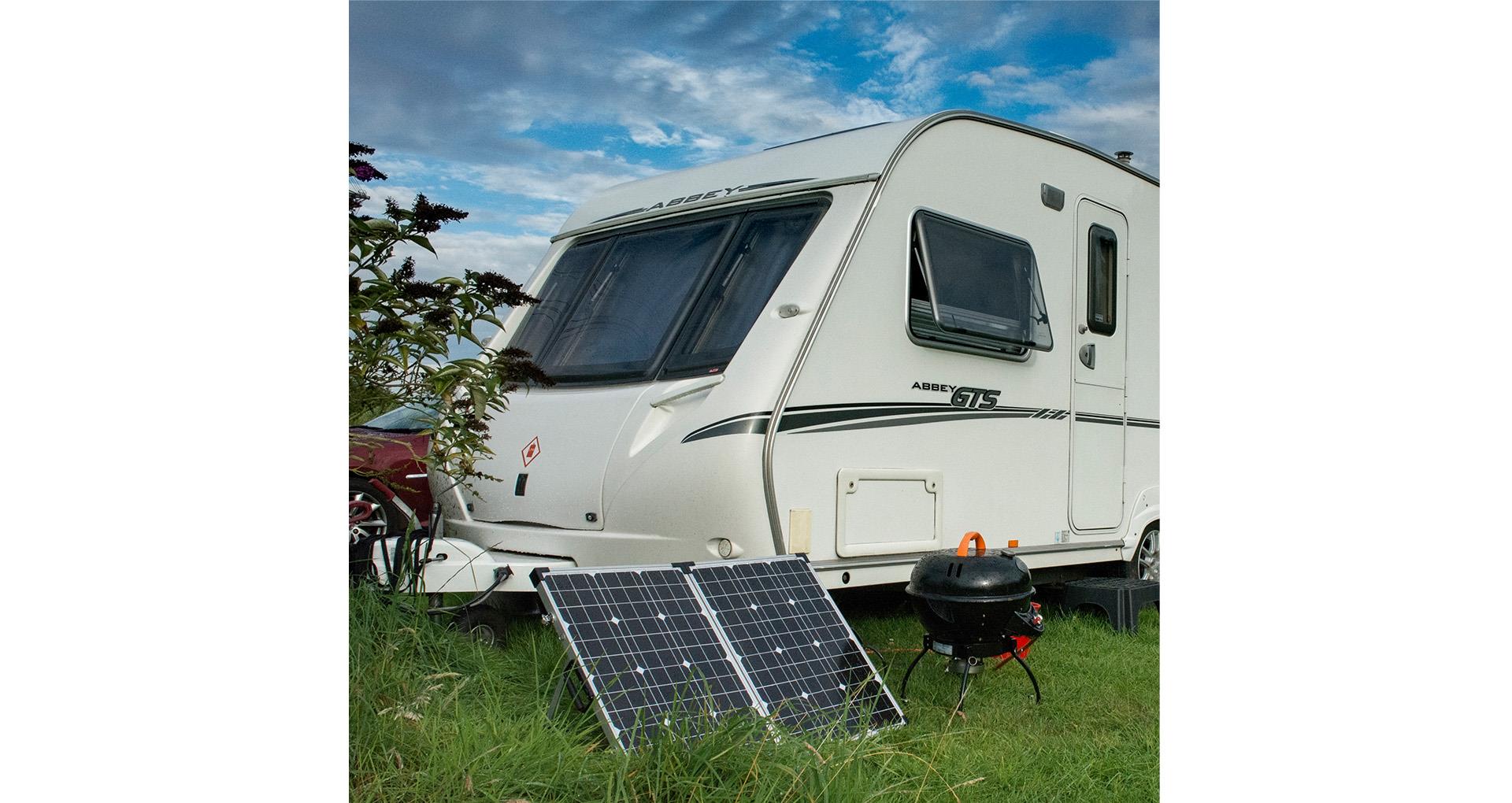
The methods and devices used to capture free, renewable energy, such as from the sun or wind, are becoming more commonplace for campers, caravanners and motorhomers in the UK. In this guide we will look at some of the common devices used to capture renewable energy for camping, consider how they work and which devices and conditions are best for capturing each energy type.
The pros and cons of camping away from a mains electrical hook-up
Many campers love the idea of going back to nature while camping. However, in our modern everyday lifestyles many of us enjoy using, or even rely on, electrically-powered devices. Often we want to take them with us on our camping breaks, which will mean opting for a camping pitch with an electric hook-up, or making use of other sources of power.
Once you’ve factored in the additional cost of a campsite electric hook-up there is a good argument for considering alternative power sources, such as energy from wind and water turbines, thermal and solar power generation, depending on how you camp.
Advantages
- There’s no requirement for a 230V hook-up on campsites, which means you’re reducing your on-site running costs in the medium term
- Freedom to camp at a wider selection of pitches and green field locations
- An ability to become a more self-contained camper
- Caravan and motorhome leisure batteries work best when topped up regularly, which is simple to achieve with power from alternative sources
- Keeping the battery charged during storage
Disadvantages
- It can be expensive to buy an alternative power system
- The alternative power system may add weight to your camping unit, and eat up some of your user payload, unless it’s factory installed
- An additional system may add complexity to your camping unit’s charging system – however, this can be outweighed by an improved leisure battery lifetime
- You will need an inverter, if you want to run 230V appliances in your camping unit – more about these later in the guide
- Some capacity and power management will be needed to ensure your leisure battery will last the duration of your break – for example, you may wish to consider switching to LED lighting, which uses far less power than standard bulbs
Common methods for capturing power from renewable energy sources
There are many different options for capturing free, renewable energy for your own use while camping. For example, have you ever let the water out of a hosepipe after it has been lying in the sun?
This is a simple but effective way of heating water and is the principal behind the solar thermal collectors on house roofs in sunny climates. However it is not practical for most camping activities, except the solar camping shower.
Wind power is an effective energy source while camping, particularly on the coast and at higher elevations, especially in the winter and at more exposed sites
But by far the most common free, renewable energy source while camping is solar power, in the form of photovoltaic (PV) generation, especially if you travel during the summer or to sunnier southern climes.
Capturing free renewable energy, then storing and using it as a power source, has three key requirements:
- An energy capture system or device, such as a solar panel or wind turbine
- A method to store the power the system produces, which for camping normally means a leisure battery
- Equipment to make use of the electricity generated – such as your camping unit’s appliances, lights, pumps and more
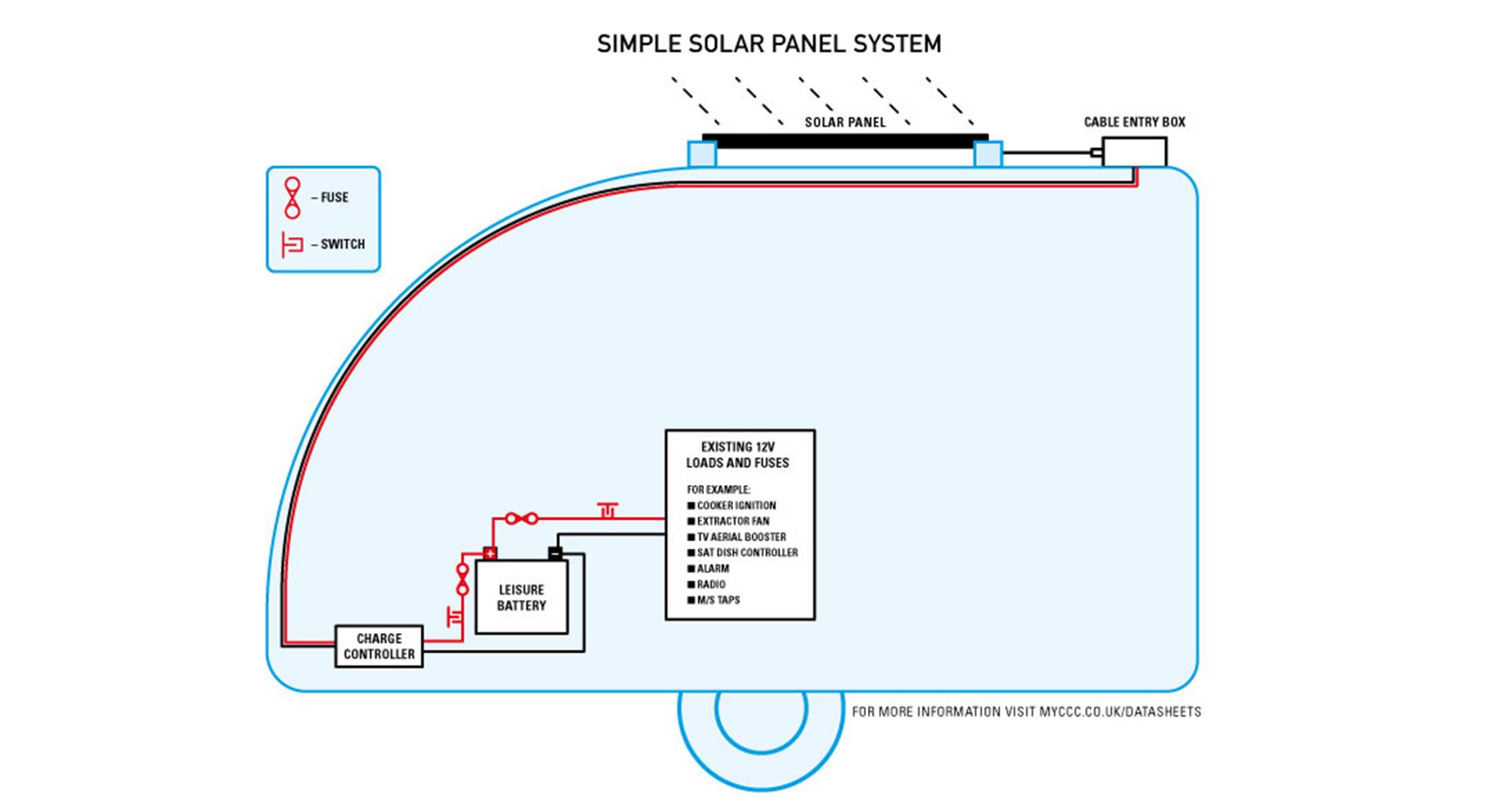 A simple solar panel system doesn't have to be complicated
A simple solar panel system doesn't have to be complicated
Options for capturing renewable energy for lightweight campers
- Small solar panels and wind turbines are increasingly popular
- Some camping accessories, such as lanterns, chargers and flashlights, have solar panels built-in to top up their charge
- Some devices require kinetic energy, such as wind-up torches
- Solar kettles are used by some campers
- Water turbines are in the early stages of production and not yet freely available in the UK
- Campfire-powered electricity generators such as Biolite stoves use excess heat produced by the fire to generate electricity, made more efficient by using a small fan
- Folding and flexible solar panels are often attached to back packs or tents
Most of the options above work best if the electricity generated is stored within a battery for use at an appropriate time. Power banks are useful for this and usually have USB outlets to charge compatible devices. Where lighting is concerned LEDs can make the most efficient use of the available power.
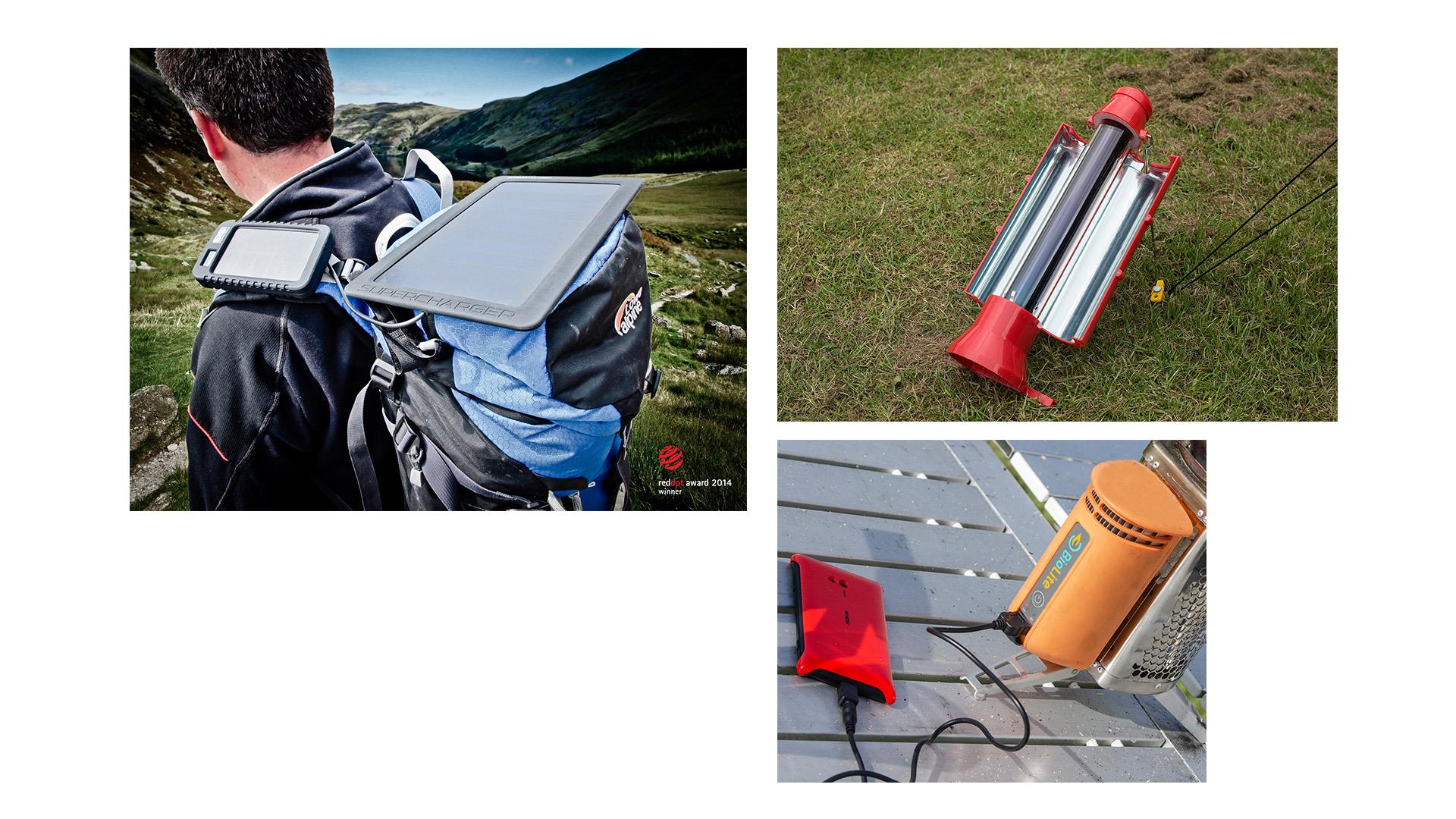
Portable solar kit comes in many sizes and shapes, a solar kettle can help boil water and Biolite stoves can charge a phone
Energy capture options for tent campers, caravanners or motorhome owners
A solar panel or similar accessory is generally used to charge up your leisure battery and it is this stored power you draw upon. Do not expect a solar panel to directly power high consumption devices such as an electrical kettle or a toaster. Instead, it can power a 12V DC TV, lights or a water pump via the battery, and also work with low wattage mains powered televisions using an inverter.
When camping in a larger tent, caravan, trailer tent or motorhome you generally have more options. Let’s explore these further.
Energy capture from wind power
Portable wind turbines have become more efficient in recent years and some Club members use them regularly, especially on extended stays. The wind turns the turbine blades and this kinetic energy rotates the shaft on a generator which outputs electricity to a charge controller. After this point the power management is similar to solar and is as shown in the previous illustration. In general a wind speed of more than 3m/s (6.7mph) is needed for the turbine to start producing a meaningful charge. However this will be produced day or night so over time they can have their merits for some users. They should be seen as a supplemental system to help with extended stays, when camping in poor weather or exposed locations. Ideally the turbine needs to be high up on a pole, which requires suitable tethering. You may need additional safety measures because of the potential hazard to other campers. Typical costs for a turbine and mounting kit start from around £500.
Solar Panels are very popular and many caravan and motorhome manufacturers now include roof-mounted systems as standard features although some will only support the battery during storage. These are the photovoltaic (PV) type so they convert sunlight into electricity directly. For those who do not have a PV panel pre-installed or need more power, typical costs start from around £140 for a solar panel and mounting kit. However it’s worth understanding more about the way solar panels work and about their limitations. This will be covered later in the guide.
Taking into account complexity, set-up time and your chosen camping location, solar power is generally the more effective option for the majority of campers.
How does a photovoltaic (PV) solar panel work?
Certain materials such as silicon display an unusual property, known as the photoelectric effect, so they can produce an electrical current when exposed to light. When light strikes a solar cell, electrons are released. These free electrons can then be captured in the form of an electric current. This can be used to charge a battery, ready for a controlled release when needed. The brighter the sunlight the more efficient this process but even on cloudy days you can still generate electricity, albeit at a lower level.
PV solar panel uses
It is now quite common to see solar panels in many situations, from wrist watches to supplementing the electricity supply at home or factory. There has even been concept motorhomes covered with them. While not a great deal has changed in the last ten years on the technology front, the real change is in the cost of panels. Now relatively large collections of solar panels (also known as arrays) are affordable enough for leisure vehicles.
If you do not have space for a fixed panel, on your camping unit’s roof for example, there are many options using flexible or portable folding ones.
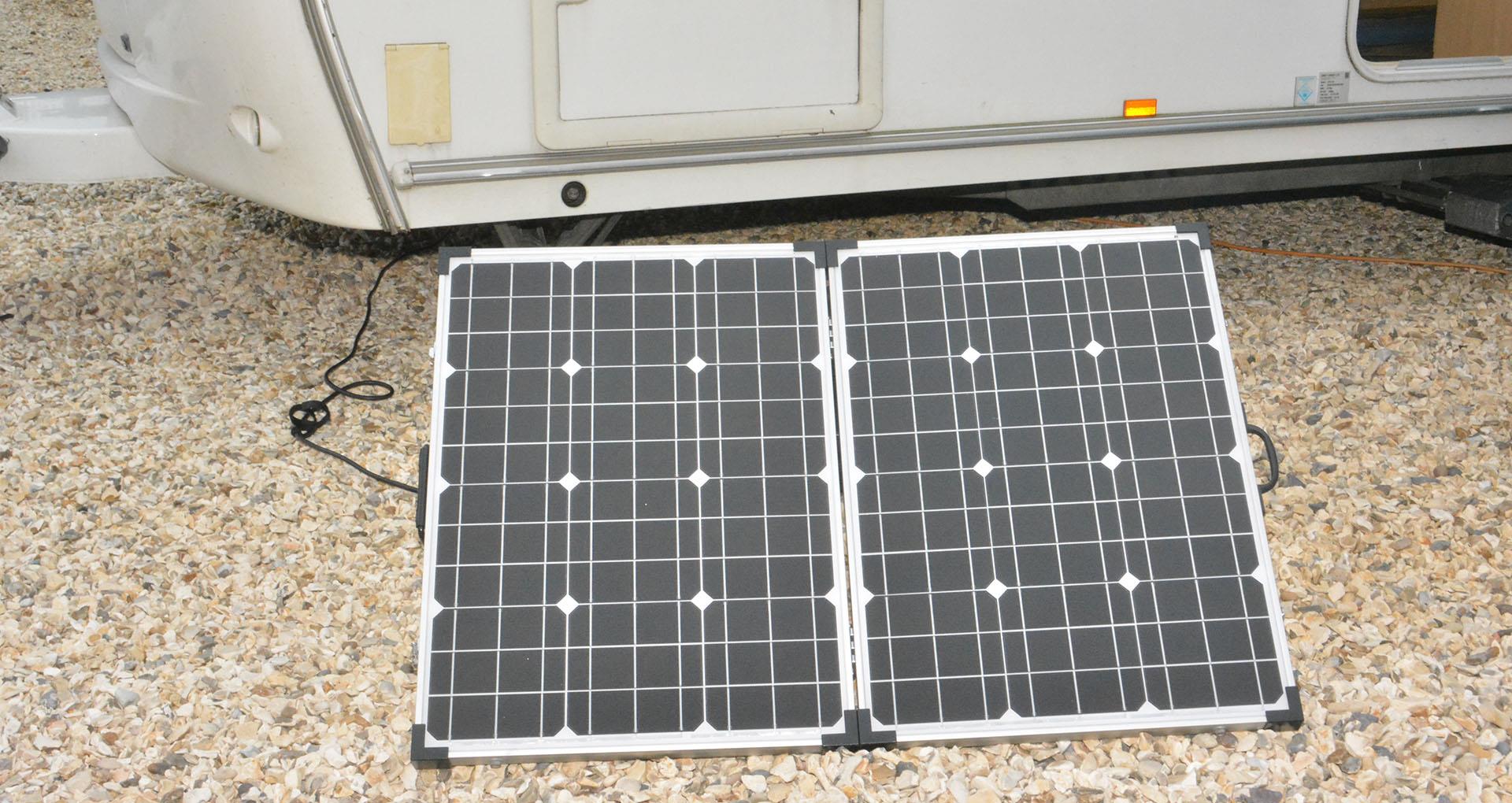
A portable solar panel can be repositioned to track the sun
In a caravan it is normally practical to use the 12V electricity supply from a leisure battery to power the lights, the water pumps, maybe heating pump or fan, television and radio.
If you calculate your battery usage then it is fairly straightforward to work out the panel size needed to charge it. We cover this later in the “Energy storage” section.
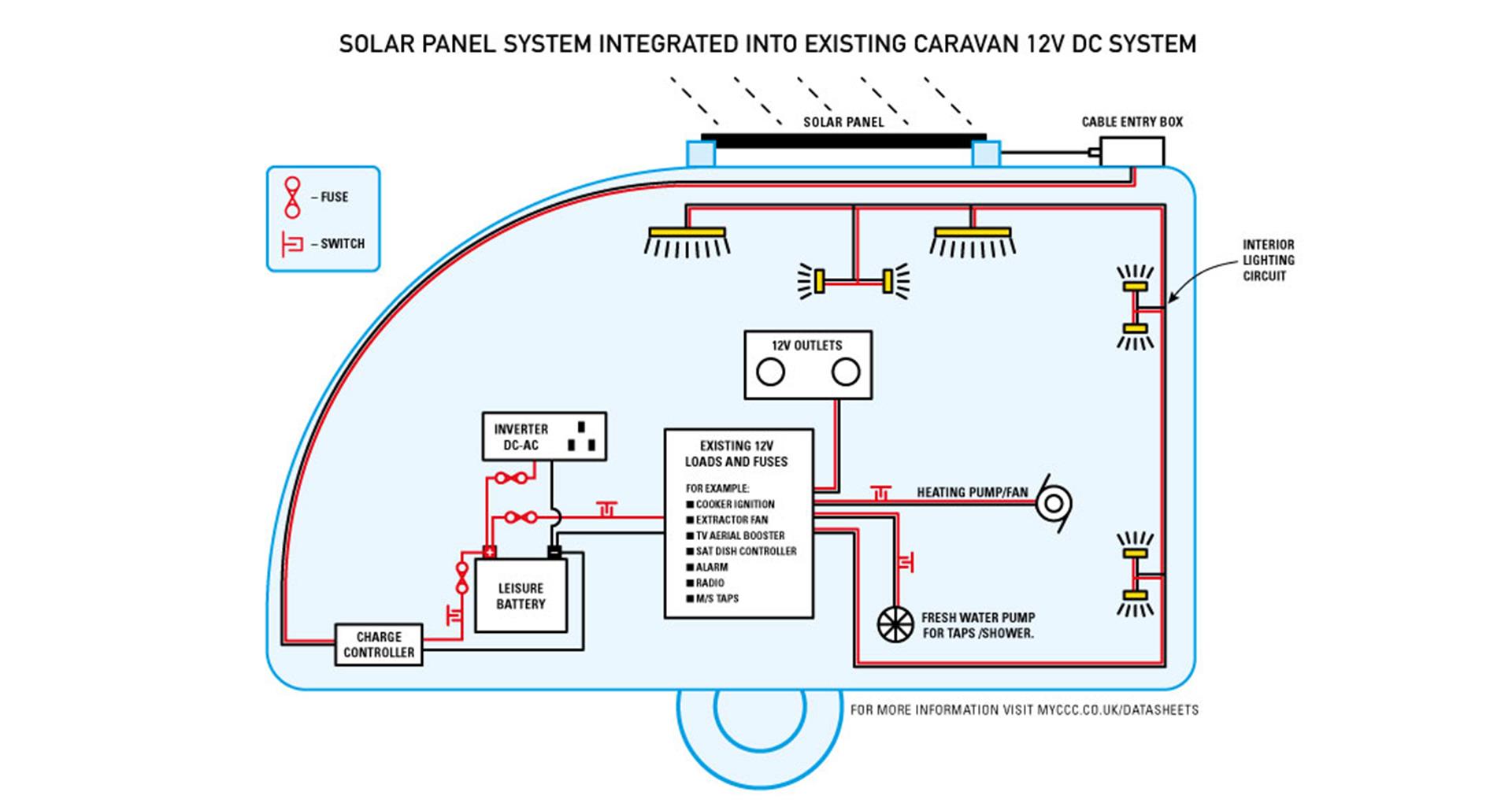
Different types of solar panels
There are two main types of solar panel: amorphous and crystalline. The latter is then sub-divided into two further categories – Monocrystalline and Polycrystalline. Each has its own advantages and disadvantages and these are explained in the glossary. It's worth understanding that a monocrystalline panel rated at 100W is likely to be smaller than a polycrystalline one of the same output. However, many panels are placed in standard-sized frames so even the size difference is not always that relevant. Do compare the panel overall size before purchase.
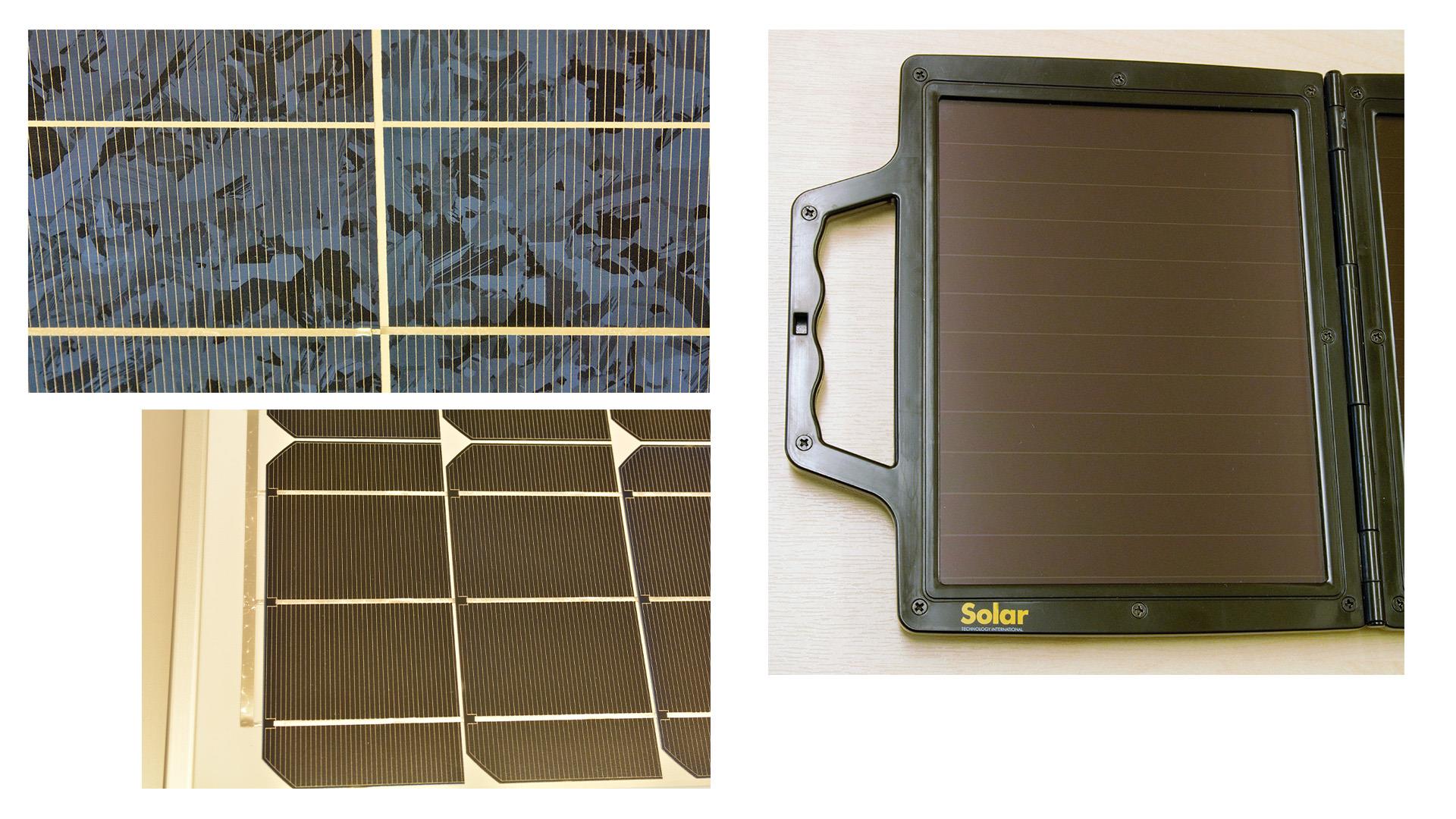
From top left anti-clockwise – Polycrystalline, Monocrystalline and small amorphous solar panels
Energy storage: What size of battery do I need?
Understanding battery capacity and your consumption habits will give you a good indication of how long your battery is likely to last, away from an electric hook-up.
One practical way to find the size of battery to suit your usage is to go camping with a fully-charged one in your unit. Do not connect to an electric hook-up or charge the battery and use your kit as normal. Note how long your battery powers everything. When you return home, do remember to charge the battery up straight away to keep it in good condition.
Find the rating of your battery (it should be marked in Amp hours – Ah) and calculate your average power consumption during your trip. For example, if a 110Ah battery has lasted for four days, that is an average of 110/4 = 27.5Ah per day. This is an over-estimate as it is impractical to drain a lead acid battery completely and may do permanent damage. In most cases you should work on using only 50 per cent of the battery capacity ie its Depth of Discharge (DoD) before the television stops working or the water pump fades, but it gives a rough guide.
A battery that is 55Ah should last half as long as a 110Ah version. Based on the 27.5Ah per day consumption mentioned above, this should give two and four days use respectively without top up. However, the larger the battery the heavier it will be, so in practical terms a solar panel is a relatively lightweight way of topping up the battery capacity.
If you do not have the opportunity to check your real power consumption on site, you will need to estimate it using the power rating label of every piece of electrical equipment you plan to power from your battery. You can find out more in the ‘Understanding your usage’ section. Working on a battery capacity that is three times your daily usage is a good starting figure.
The capability of any electric charging system is usually rated in Watts (W). PV panels and wind turbines vary in size, practical systems for charging motorhomes and caravans typically need to capture from around 30W to 200W depending on your usage, with an accompanying increase in costs.
The wattage of the solar panel is the most important thing to get right. Too small of a panel and it will be unable to put any meaningful charge into the battery. Too large and you will have excess capacity, which will cost more and weigh more too.Understanding your usage
Your battery produces roughly 12V to power your equipment, so to work out the drain on your battery from an appliance, take the power rating and divide by 12.
For example, a light draws 16W, divide this by 12V = 1.333A. Turn it on for three hours a day and you will need 1.333 x 3 = 4Ah every day from your battery to power that single light.
Use a 45W 12V television for 2 hours and you will need 2 x 45/12 = 7.5Ah every day from your battery.
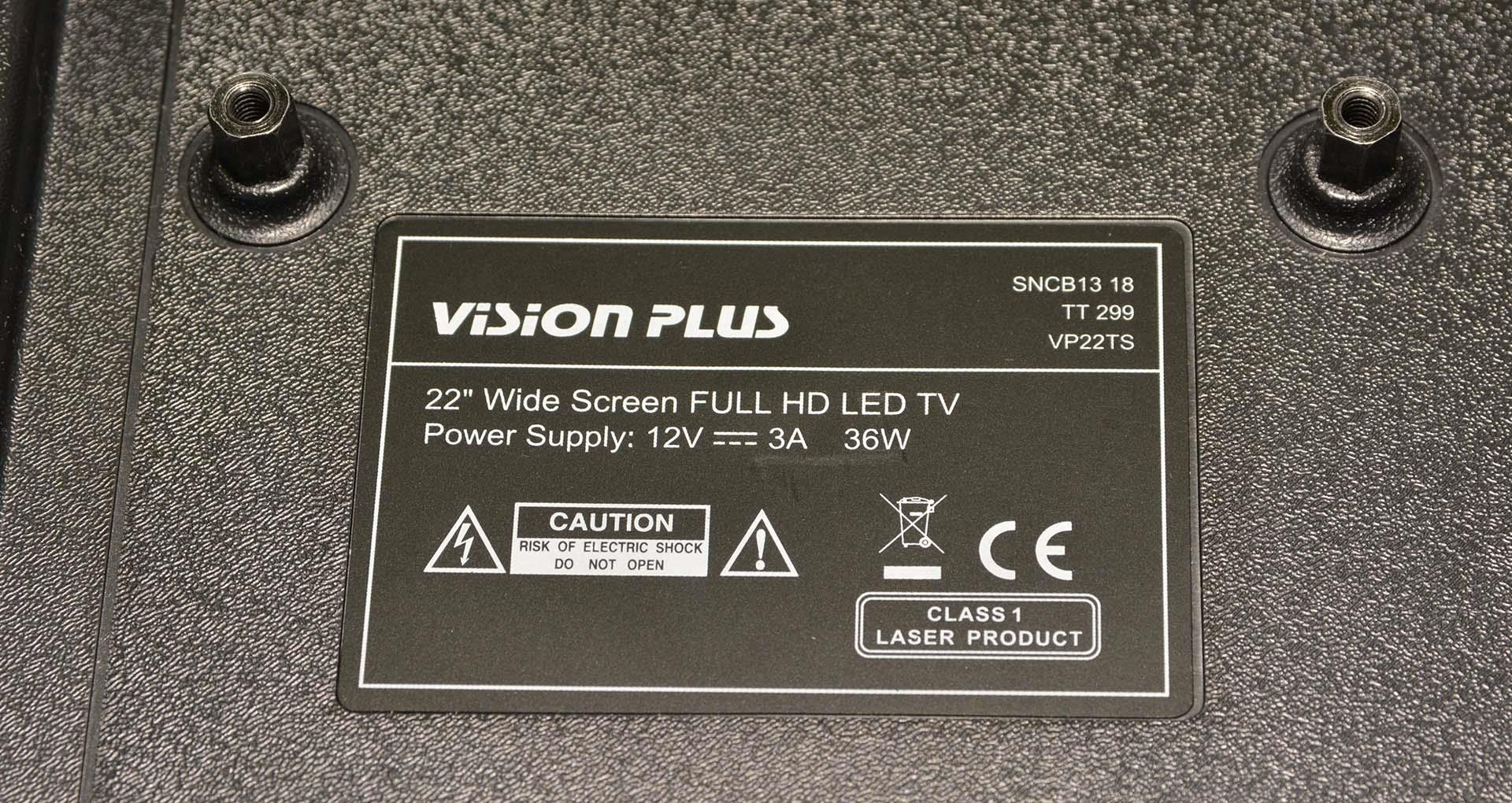
Check the power rating of your equipment which should be marked on the label, here it is 36w
Simple formula for power, energy and capacity
Here are a few formulas to help you work out your usage
- Power in watts (W) = current in amps (A) x voltage in volts (V)
- Energy in watt hours (Wh) = power in watts (W) x time in hours (h)
- Battery capacity in amp hours (Ah) = energy in watt hours (Wh) / voltage in volts (V)”
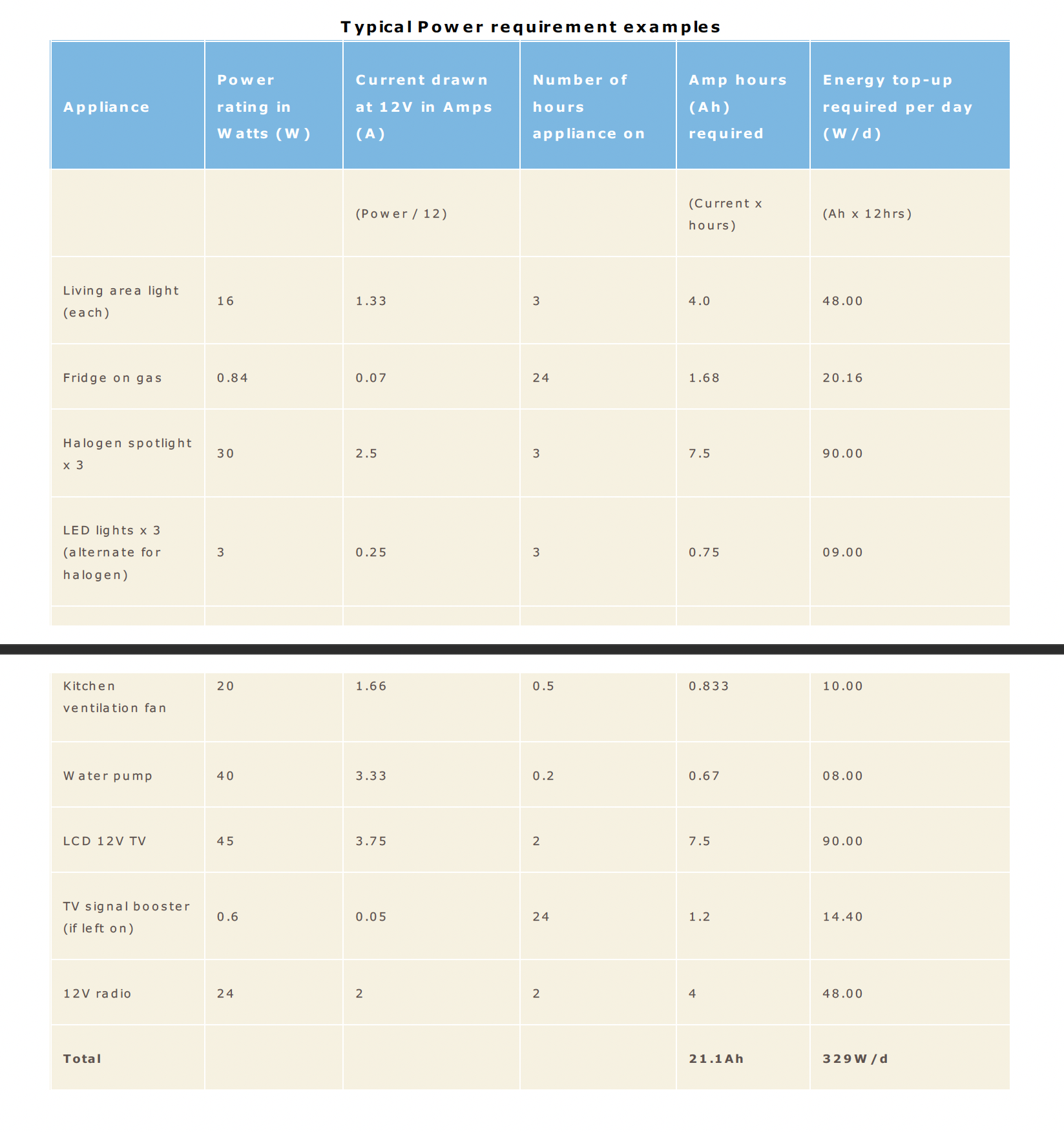
Sizing a solar panel for UK use
Using the appliances listed in the chart above, if you camp on a site using all this equipment in summer you would need at least a 66W panel to top-up your battery – assuming 5 hours of usable sunlight to give 5hrs x 66W = 330Wh. This allows for most of the typical losses that are experienced.
Remember to take into account the time of day when you use the appliances. For example, if you are draining all the power when it is still dark your battery may be dropping below 50 per cent charge before being topped up, which can reduce its useful life expectancy. It may, therefore, be worth upgrading your battery to a higher capacity to support your camping lifestyle.
An option for some may be a large Lithium Iron Phosphate (LiFePO4) battery – these are significantly lighter than traditional lead acid batteries and the DoD is greater.
Standard Test Conditions: What does this mean in the real world?
On the label that is attached to solar panels will be information related to Standard Test Conditions (STC). These are laboratory condition tests used to measure the power output of a solar panel. Solar panels sold in the UK will be marked with a power rating. Although these are very specific conditions (see the Glossary for more details), the existence of STC means you can compare the power outputs of different solar panels quickly and use this as a guide to finding out what you will need to match your camping style.
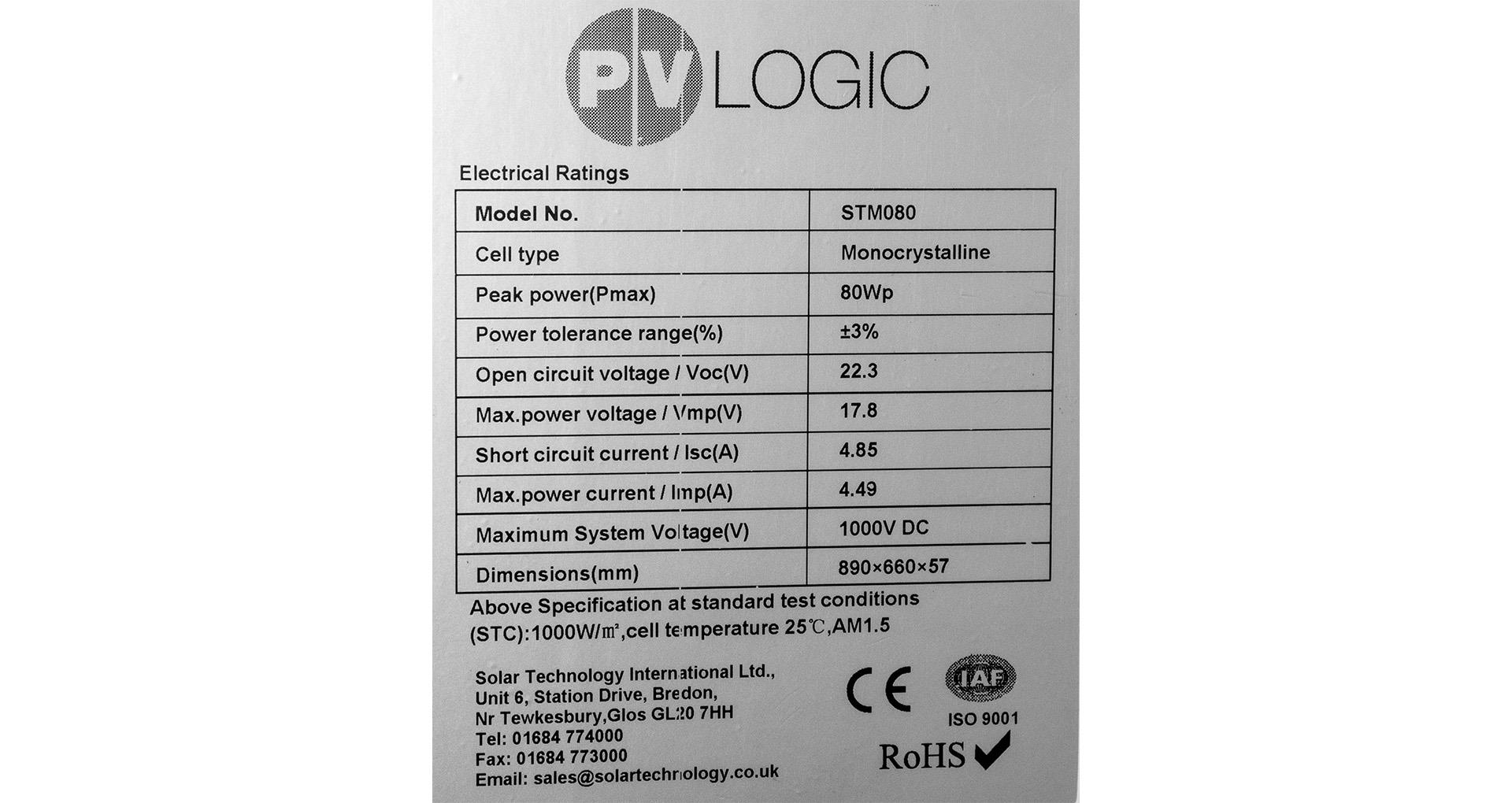
A typical solar panel label with STC information allows direct comparison between different solar panels
The ratings mean if you were to put three panels in the sun, one 4W panel should generate the same power as another 4W panel and a fifth of the power of a 20W panel. However, this does not mean you will get 4W (or 20W) every hour during the day.
Fixed solar panels verses portable models
Some solar panels are portable and come with all the connectors required to attach them temporarily to your leisure battery. Others can be permanently secured to your roof and may come packaged with a suitable fixing kit. When permanently fixing a panel make sure nothing on the roof (such as a satellite dish or TV aerial) might shade it. Before you buy, think about how and when you will use the panels, including whether they will normally be positioned in full sunlight. If you have them permanently fixed, consider whether the attachment will affect the water ingress warranty of your unit. Make sure panels are positioned to take advantage of the midday sun. This is almost directly overhead in summer but lower in the southern part of the sky at other times of the year. Matching your panels’ angle to the sun’s position will increase the energy it gathers outside the summer months. In recent years tracking solar panels have become available, both fixed and portable that follow the sun. These are worth considering to maximise your solar input.
Summer and winter use in the UK
On an average summer day you could expect the equivalent of about 5-6 hours of Standard Test Conditions (STC) illumination on a panel pointing towards the sun. Hence a 50W panel could generate about 250-300Wh per day on a flat roof, with a 100W panel producing 500-600Wh. That is potentially 21-25Ah stored in your battery with the 50W panel or 40-50Ah with the 100W one (calculated by taking the wattage per day figure and dividing by 12, the battery’s voltage).
During the winter months the sun gets quite low and the days are shorter. To compound this you are more likely to have lights on for longer and be using power to pump or blow heat around your van. The same panel will likely only gather the equivalent of one hour’s output so that 100W panel will only generate 100Wh.
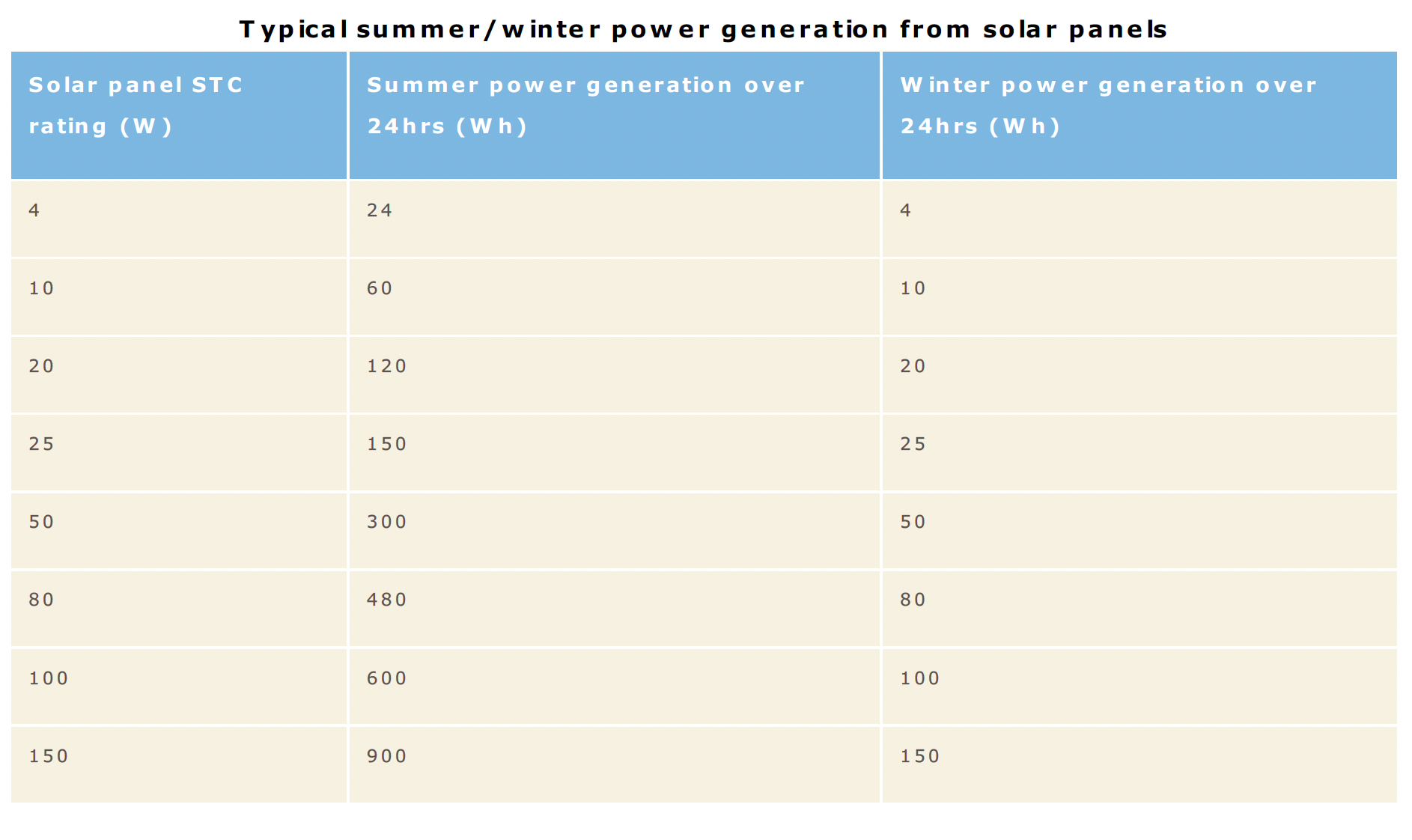
An additional portable solar panel can be used to supplement your summer panels. It can also be aligned easily to capture the maximum sunlight from the low winter sun. Camper vans with pop-up roofs may not need to do this as long as the roof slope can be pointed south.
Getting the most from your solar panels
Keep them clean and regularly check the security of roof mounted panels, along with the electrical connections and wiring, to prevent issues in use. If you use a crystalline panel, do not forget the shadow from a TV aerial can make a difference to the power output. Make sure as many cells as possible are in full sun. Bypass diodes built into the panel circuit help reduce the effect of shading, which could severely reduce the output and even cause a hot spot on the panel without them. The bypass diode will prevent the shaded area being fed by the remaining cells trying to achieve an electrical balance.
Solar panels will work behind glass, but with limitations. They are designed for direct sunlight and have special low iron glass to allow easy transmission of light. If you put a panel behind normal glass or a plastic window its efficiency will be severely reduced. It may take up to five times as long to provide the same charge to a battery even if it is in full sun.
The power generated by a solar panel is Direct Current (DC), so it will charge your leisure battery and power 12V appliances and lights. If you want to use it to power something that would normally plug into a home-style three-pin 230V socket you will need to convert it to Alternating Current (AC). For this you will need an inverter. Be mindful these have inherent losses – for example to draw a 100W you'll need around 120W or 10A taken from the battery. For more information on inverters see our guide here.
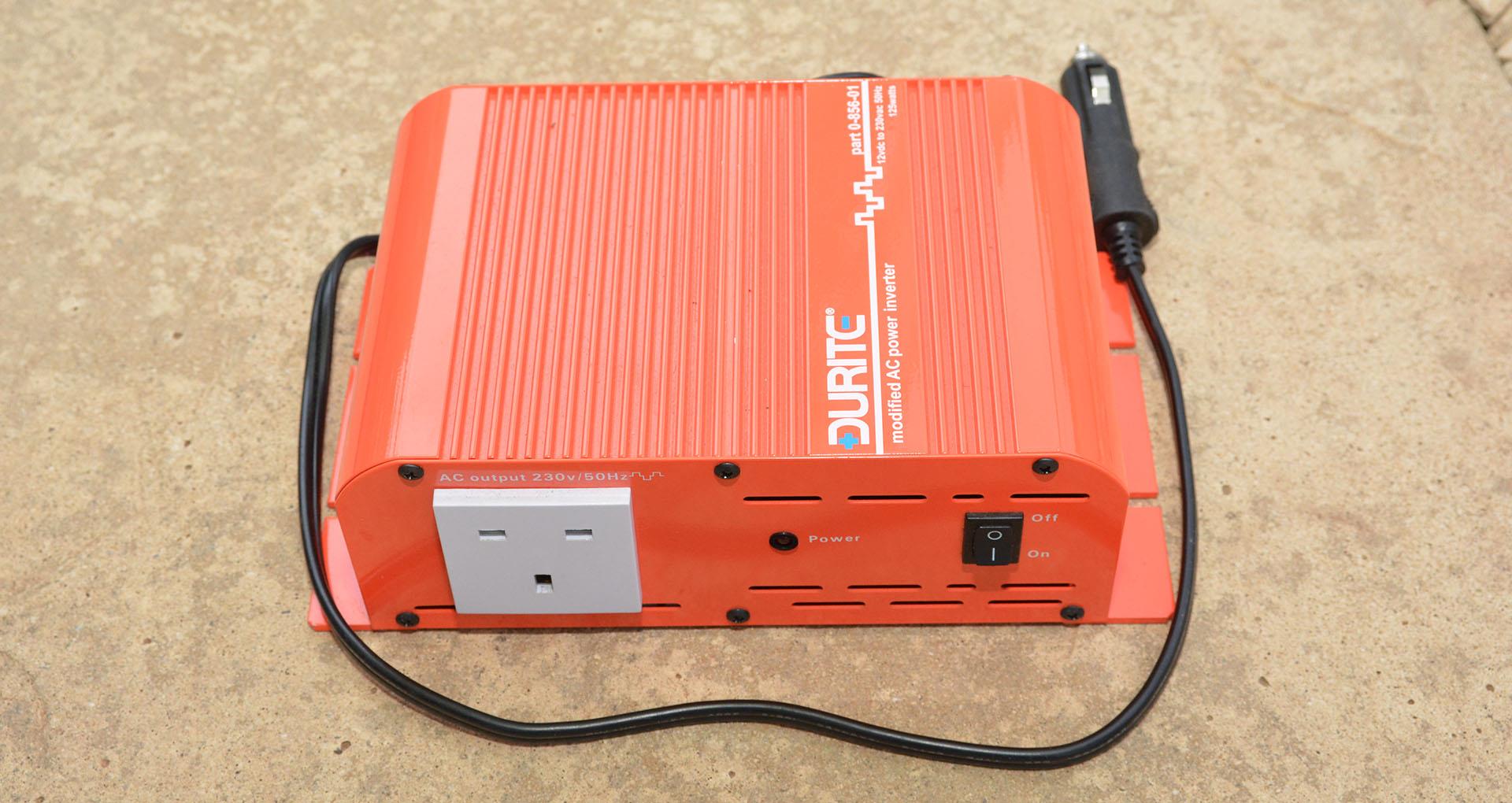
An inverter can convert 12vdc to 230vac for small household appliances
The power you generate from your solar panel will only be as good as the condition of your leisure battery, so it is worth looking after it, see our guide on batteries for more information.
When your caravan or motorhome is in storage a solar panel can be ideal for keeping your battery topped up, especially if you have a battery-powered alarm system. Remember to take into account the low light levels in winter when calculating the panel you need for this and consider the effect of overhanging branches and falling leaves shading the panel.
Installing and managing solar power
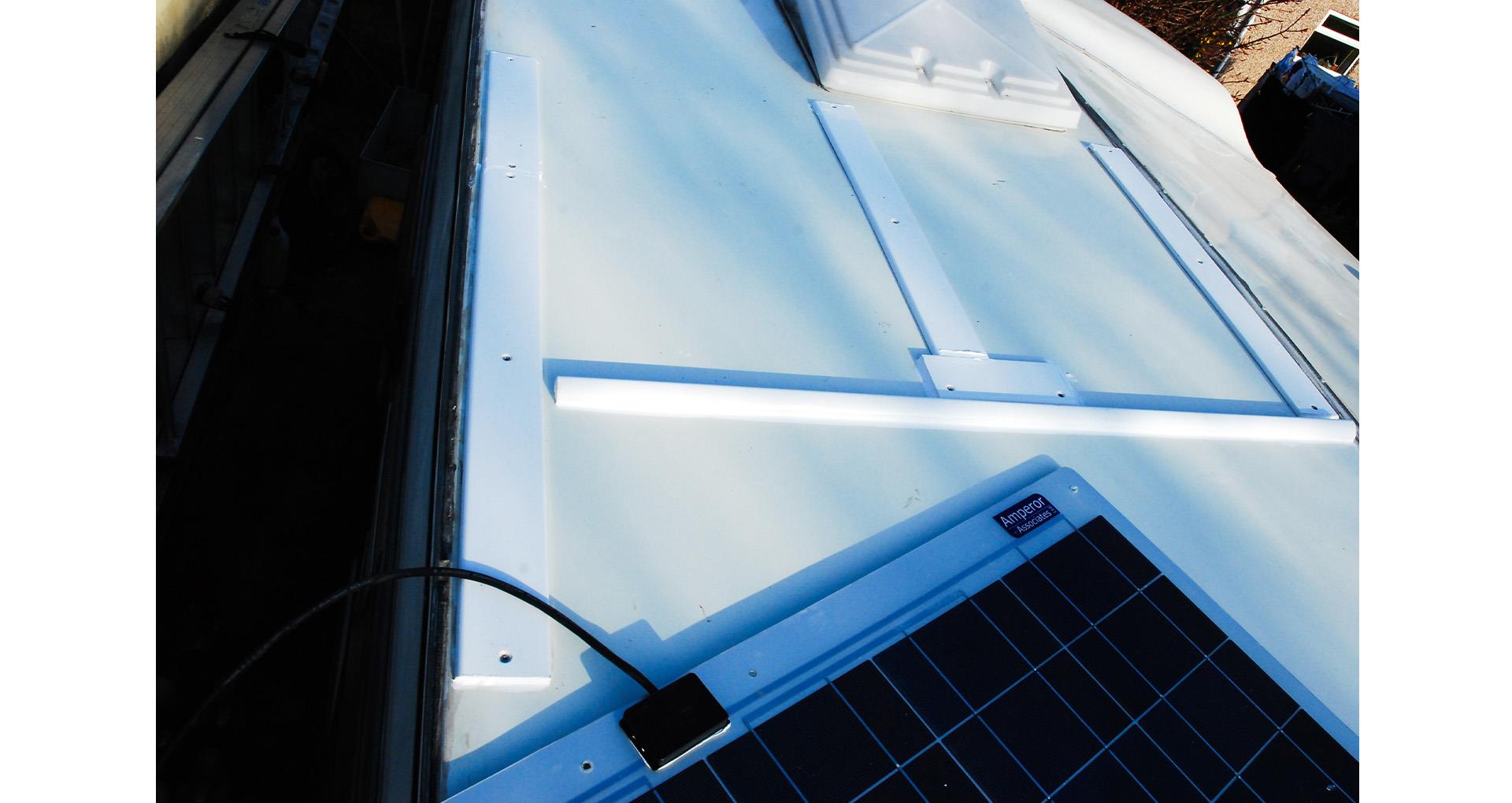
Preparing a roof for solar panel fit
There are several things you will need to take into account when installing solar charging. The most important is your safety. If you don’t feel confident or able to carry out such work, contact your local Approved Workshop Scheme (AWS) member who can carry out the work for you.
Cabling
Any 12V system will suffer with voltage drop in its electrical cables as the voltage is relatively low. Voltage drop is caused by internal resistance within the cable which causes loss of voltage over the length of a cable. The longer and thinner a cable is, the greater the voltage drop will be. In a charging system this equates to a loss in efficiency. Using shorter and thicker cables it should be possible to achieve losses below 3 per cent, which is considered acceptable. There are online calculators to help determine voltage drop.
Fuse
You must install a fuse close to the battery to protect against any short circuits, overloading or other faults. Consider including some form of isolation switch, sized according to your system’s capability.
Blocking diode
All solar panels need a blocking diode. This prevents the current flowing back to the panel from the battery when it is dark, causing a loss of charge from the battery. This may be built in to the regulator if one is fitted.
Over-charge management and regulation
Larger solar panels can over-charge your battery. To check whether you need a regulator or charge controller to stop this, take the rating of your battery in Amp hours (Ah) and divide by ten. If the power (in watts, W) of your solar panel is lower than this figure you will not need a regulator. For example, a 110Ah battery connected to a 10W solar panel (110/10) = 11, therefore no regulator is needed. If however your panel is 15W you will need a regulator to restrict the current to a safe level.
Today most solar panels for leisure batteries will need at least a simple regulator. Many kits sold for caravans and motorhomes will have one, but it is worth checking. However, we recommend the use of a charge controller rather than a basic regulator. This manages the supply from the panel to the battery in a more efficient manner and should include the features mentioned previously.
Charge controllers
The main role of a charge controller is to automate the charging process and protect the battery. It does this in a number of ways:
Reducing the level of charge reaching the battery
- This prevent over-charging which is likely to damage the battery. Also note overcharging could result in explosive hydrogen gas being released
Monitoring the battery voltage
- A low battery voltage is detected by the controller when the battery drops below a specified level. It will then disconnect the charging function from the battery in order to protect the system
- A completely drained battery will likely be damaged and will lose some of the overall capacity
Preventing reverse current flow to the solar panel at night
- A blocking diode as mentioned earlier will prevent this
Types of charge controller – which is best?
The simplest charge controller will just open the charging circuit when the battery voltage gets to a pre-determined level.
More complex PWM (Pulse Width Modulation) controllers sense the battery capacity and slowly lower the voltage as it reaches capacity. In general this is better for the battery than providing a constant voltage. Such controllers will also warn of faults detected within the solar charging circuit. PWM is the common and relatively inexpensive option for smaller solar arrays.
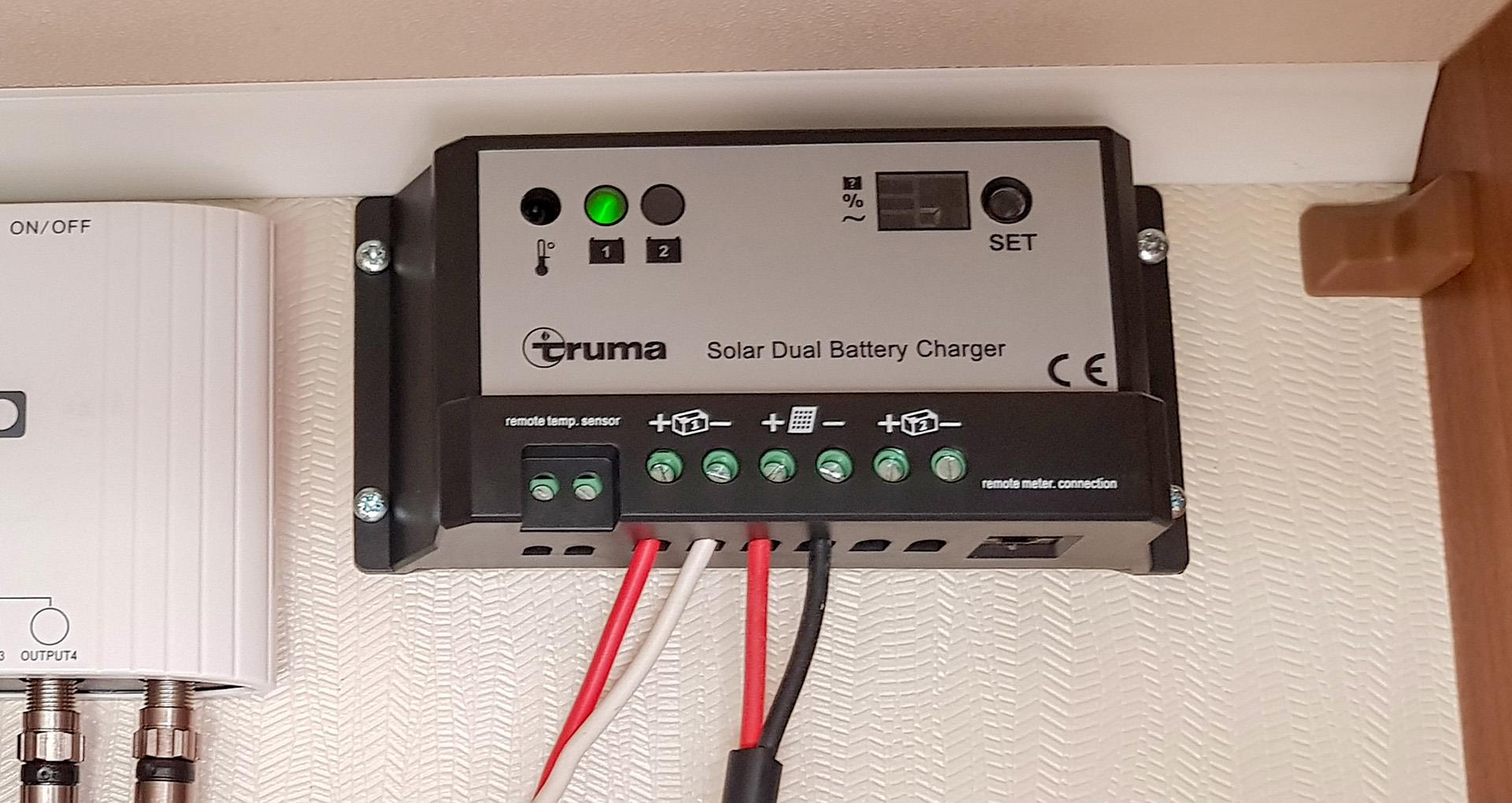
A typical PMW charge controller
Multi Power Point Tracking (MPPT) charge controllers are the next step up from PWM ones. They convert more of the usable energy being produced by the renewable energy source and captured by the solar panel or other system, charging the battery more quickly and with less chance of damage over time. As you might expect, MPPT controllers are more expensive than PWM ones.
MPPT is the best option for larger arrays. Systems over 500W would definitely benefit from installing an MPPT, though this is a significantly higher wattage panel than most caravans and motorhomes will have fitted. However, an MPPT may allow setting for different battery types and remote display of system performance so is more flexible.
Sizing your system while touring outside the UK
In this guide so far we have assumed you will be camping in the UK in the summer. So what if you wish to travel to places with different climatic conditions?
The map below shows the solar potential across Europe. Travelling south into mainland Europe would generally mean you would need smaller panels as you can capture more intense sunlight for longer. However, you need to consider the efficiency of the panels as the temperature rises. Over 25C the panel will lose 0.08V per degree C rise. Conversely below 25C the efficiency increases by the same amount.
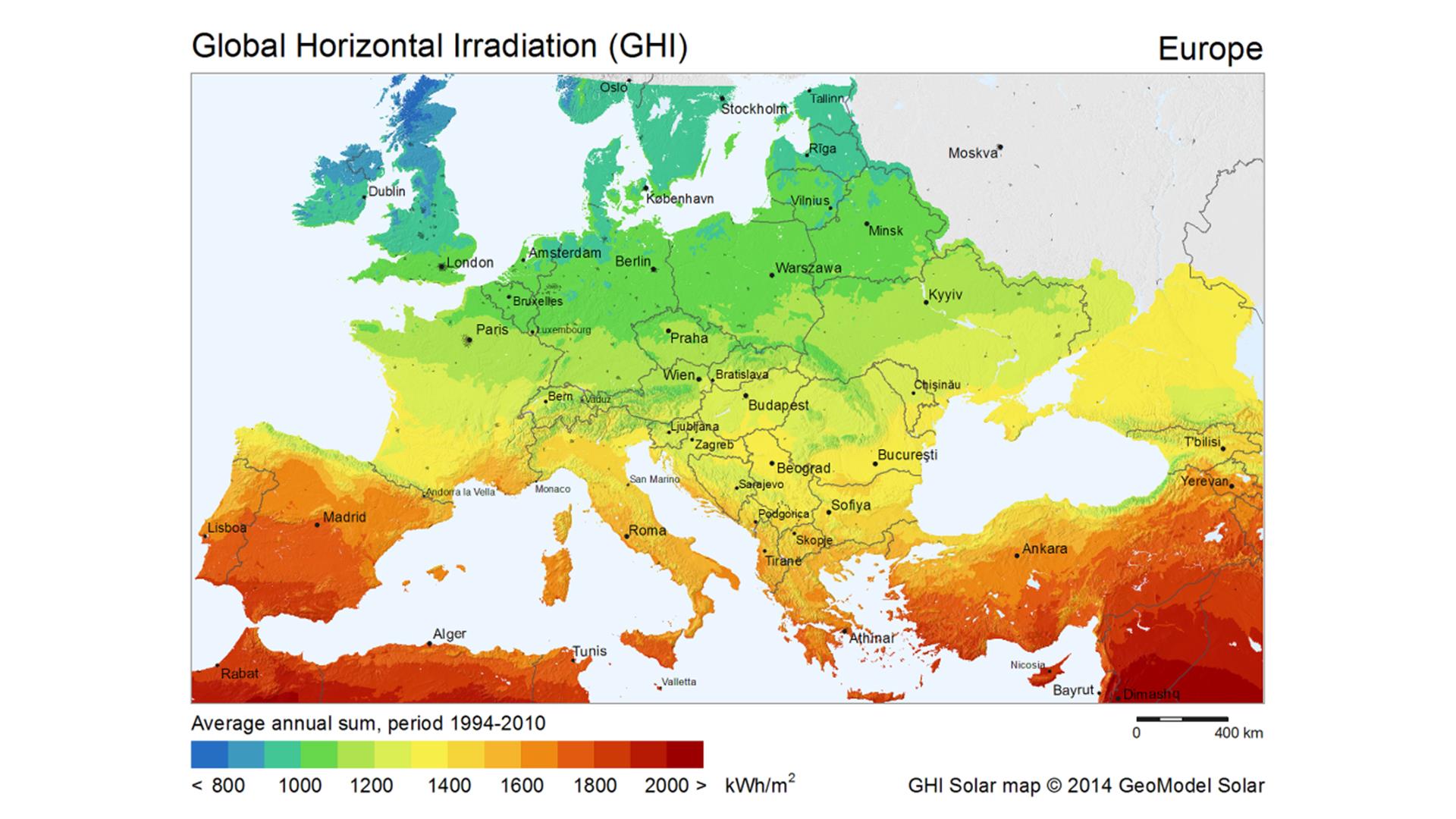
This map shows solar potential across Europe. Kindly supplied by the European Commission, Joint Research Centre
Solar panel top tips
- Let your insurance company know you are installing a solar system, to make sure your investment in technology is covered by your policy
- Give thought to sizing your solar panel accurately, to ensure you cover your power requirements but also to avoid disappointing performance while camping, or costly over specification
- Take care of your leisure battery. Your 12V system relies on it to deliver power to appliances. If in doubt get it checked by Approved Workshop Scheme (AWS) member
- Always try to position the panel so it can see the sky without interruption – ie, not shaded by trees
- Keep it clean – a small amount of dirt can make a big difference to the panel’s electrical output
- Portable panels should ideally be repositioned during the day to benefit fully from sunlight and the sun’s apparent path through the sky
- Secure portable panels to prevent theft
- While in storage away from mains power a solar panel can be invaluable for keeping the battery topped up
For more information on batteries and their care see our guides on leisure batteries and charging a leisure battery.
Useful further reading
- Campsite Electricity
- A guide to caravan and motorhome servicing
- A guide to winterising a caravan
- A guide to winterising a motorhome
Other useful contacts
SOLAR PANELS AND ACCESSORIES
http://www.solartechnology.co.uk/
WIND POWER
https://www.marlec.co.uk/
The Photovoltaic Solar Electricity Potential in European Countries map is available here to download.
Please note inclusion on this page does not constitute endorsement by The Camping and Caravanning Club.
With thanks to Sean Gunston for help in the preparation of this information.
Glossary
Amorphous solar cell
One of the main types of solar panel. Consisting of one or more sprayed layers of photo voltaic material. Usually they are physically larger than crystalline panels of the same wattage due to inefficiencies. Characteristics include:
Amp hour (Ah)
A unit of battery energy capacity, used to measure a battery’s total capacity. The larger the number, the greater the battery’s capacity
Amp (A)
A unit of electrical current
Current
The flow rate of electricity around a circuit. Measured in Amperes (A) or Amps
Depth of Discharge (DoD)
The amount a battery can safely be discharged before topping up. If the battery has delivered 50 per cent of its charge, its DoD is 50 per cent. This is the typical limit of discharge for a lead acid deep cycle battery
Efficiency
The ratio of sunlight power hitting the solar cell to the electrical power it produces. Mono-crystalline efficiency is in the region of 15 to 22 per cent
Inverter
A device that converts 12V direct current (DC) (as provided by a leisure battery) to 230V alternating current (AC), as used from a standard three-pin socket at home
Imp
The current of the panel at peak power output
Isc – Short-circuit Current
The maximum current the panel can generate
Monocrystalline solar cell
Basic type of solar cell for the majority of solar panels. Characteristics include:
- Uniform look created from a large silicon ingot crystal sliced into thin wafers
- Wafers have rounded corners which reduces their surface area slightly so they are more space efficient than other types
- Rigid or semi-flexible construction
- Better low light performance
- Shading can severely affect their performance
- They are more expensive to produce but have a longer life
Photovoltaic (PV)
The process of converting light into electricity
Pmax Peak Power
The amount of electrical power produced by a solar panel when exposed to sunlight at an intensity of 1000W/m2
Polycrystalline or multi crystal solar cell
This type of solar cell has more impurities within it as it is not formed from perfect crystals so is less efficient. Characteristics include:
- The raw silicon is melted down and decanted into square moulds which cool to form multi-faceted cells
- Less heat tolerant
- Cheaper to make
- Reduced efficiency means panels are slightly larger than an equivalent monocrystalline panel. However, in leisure use the difference is marginal
- Rigid or semi-flexible construction
Power (W)
The rate at which work is done. It is the product of voltage and current measured in Watts
Standard Test Conditions (STC)
The STC uses a light intensity of 1000 W/m2 (roughly the intensity of the sun in the UK in summer), a specified spectrum of light to imitate the sun and a temperature of 25C, plus or minus 2C to measure the output of the panel at an angle of 48.2 degrees to the sun
Voc – Voltage, Open Circuit
The voltage of a PV panel with no load, when it is disconnected. A 12V Nominal PV module will produce about 20V open circuit
Voltage (V)
The electrical potential difference between two points in a circuit, measured in volts
Vpp – Voltage, Peak Power Point or Max power (Vmp)
Voltage at which a PV panel transfers the largest amount of power. A 12V Nominal PV panel will typically have a peak power voltage of around 17V
Watt (W)
The unit of power expressing the rate of energy conversion
Watt hour (Wh)
A measure of electric energy equal to one watt used in 1 hour, also known as Electrical Energy
